Digital media homepages are cluttered with widgets for various sections, leading to higher bounce rates and accidental clicks.

This difference places the cognitive load and choice fatigue on users.

In contrast, algorithmic platforms—social media, search engines, and OTT services—present users with a simple, sorted list of content to choose from.

Meanwhile, on algorithmic platforms, this burden is shifted to the recommender algorithms, making it easier for users to find what they want.

GIF Credits: Ralph Ammer
 Copied
CopiedGoogle Sheets stores formatting separately from information. Similarly, the advent of Generative AI will force information products (Search Products, Social Media, etc.) to separate the core information value and the form, format, style, and tone it is presented in. Without this, we are in for a flood of similar content that is written just slightly different.
Historically, modern CMSes like Washington Post’s Arc CMS went headless and started storing the story and its presentation (HTML tags) separately. We’ll now have to extend this further.
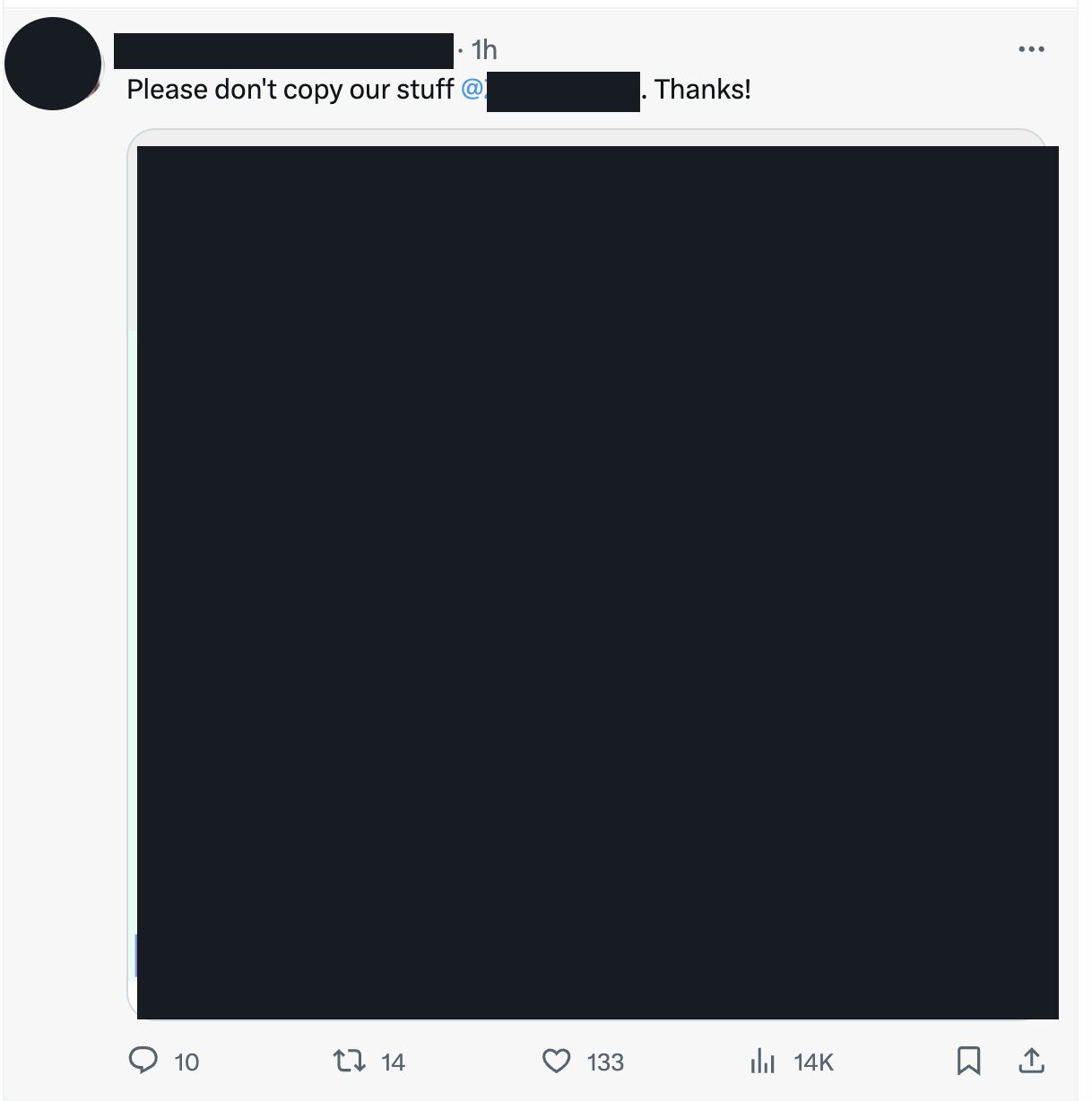
 Copied
CopiedUsers are able to use products for free because they give their time and attention which is then monetized through advertisements.
The customer’s perspective
Companies invest in advertising for:
- Brand Development: Brands advertise to maximum folks should know about your product (Owned Identity) to drop their Customer Acquisition Cost. All print and TV advertisements were for brand development. In such campaigns, the focus is on CPM while maintaining a basic CTR.
- Performance marketing: In this brands get Paid or Acquired Traffic for a specific business objective, for example, app installs, lead generation, or conversions. Agnostic to the method you use, what matters is the outcome that you promised and hence such advertisements are paid in the form of CPC, CPL, CPA, and CPT.
Companies will pay a premium for:
- Reach
- Performance
- If you can prove that the audience that comes to your platform is their target audience. Alternatively, if you can use artificial intelligence to target advertisements.
- If you can prove that your platform is a premium space.
Limitations of the ad-funded model
Indirect programmatic advertisement is bad for business and users. Yet, most companies adopt it because it is a relatively easy plug and play revenue channel.
Bad for business
- Bottom feeding. Most companies have not been able to monetize advertisements as efficiently as Google, Facebook, Amazon, and Apple. Hence, even when large organizations do direct sales of advertisements, they are fighting for the peanuts left behind.
- Downturns can hit hard. Companies spend on advertisement from their marketing budget which tends to be a variable expense. Hence, during a downturn or recession, ad-funded businesses are hit hard as companies stop spending this variable expense.
- Lack of consistency. Revenue from advertisements is seasonal.
- Converts your business into a commodity.
Bad for users
- Ideally, you must under-optimize. Adopting ads as a revenue model is all about managing tradeoffs: How to serve the needs of advertisers while retaining user delight.
- Eventually most will compromises on the product. Ad-funded economy has fused with acquisition through SEO. Hence, organizations tend to prioritize quantity over quality, i.e., create many low-quality articles to game the algorithm. Additionally, each story is valued by the page views it gets. Given that, a well-researched article and a funny cat video are measured by the same metric. Finally, the UX is extremely cluttered. It is this bad UX that has led to the creation of ad blockers.
Historical context
Ad networks solve a tangible problem:
- Without ad networks, it isn’t feasible for companies to individually buy advertisements from each website.
- Without ad networks, standardization of ad sizes and prices isn’t feasible.
Print and TV advertisements v/s Digital advertisements
What’s next
The pivot to privacy brings in new opportunities!
- The Internet is sunsetting the third-party cookie. Various governments are enforcing stricter privacy rules. Finally, platforms like Apple are by default disabling tracking.
- Companies that have implemented their own DMP that tracks First Party Data will be able to target advertisements better. For example, Vox’s Chorus.
 Copied
CopiedAs per newslifespan.com, there are four types of news topics:
- Short Shelf Life content, like Breaking News
- Long Tail
- Slow Build-Up: Events such as the World Cup and elections exhibit a gradual increase in attention, climaxing at the event’s culmination.
- Decaying Big News: Initially, a major news event captures widespread attention, but public interest gradually wanes over time.
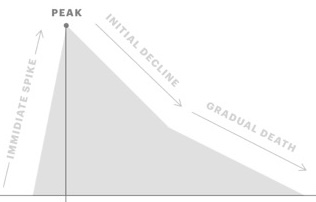
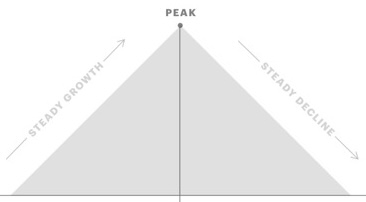
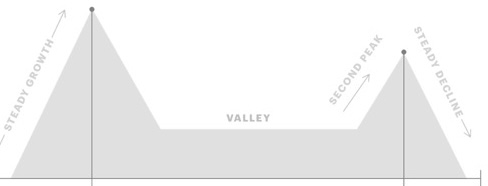
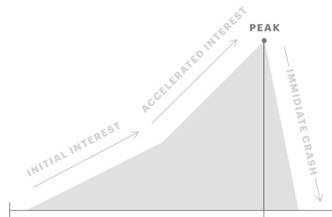
 Copied
CopiedWe write one article for everyone. However, in real life, would you tell a story to a close friend, an office colleague, and a child in the same way? Today, personalization is labeled “For You.” In the future, it will be “Written For You.”
Here’s how:
- Just as Google Sheets stores formatting separately from information, editorial teams will have to Separate information from formats.
- Let LLMs (Large Language Models) rewrite them for each user.
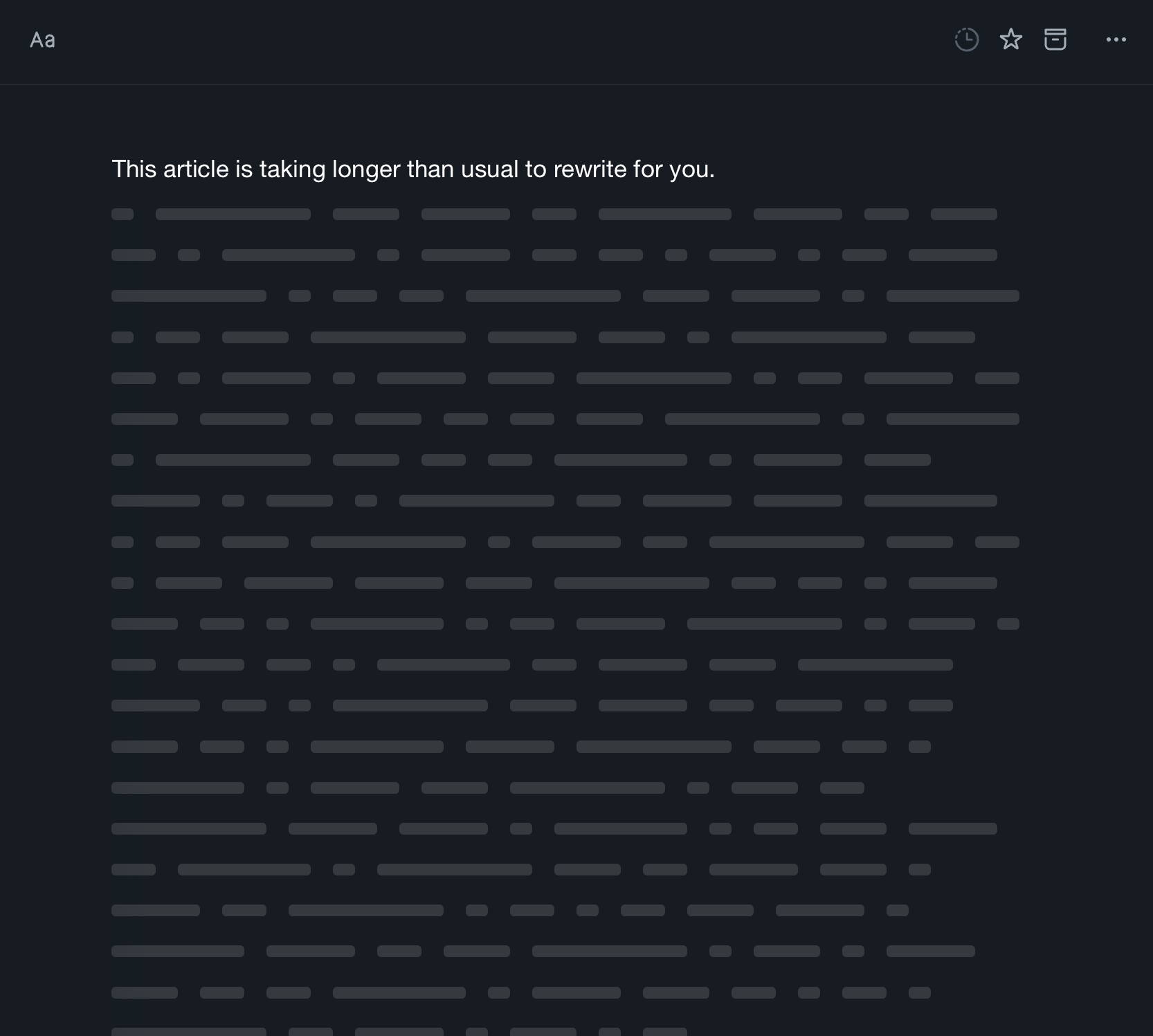
 Copied
CopiedLikely Factors
Twitter understands what is important based on if the content is about a big handle and if the topic in the content is being spoken about by big handles.
Observations
It seems that Twitter has implemented a rule on top of its recommendation algorithm. It’s common to see a retweet or reply to a specific tweet, let’s call it ‘Tweet X,’ in your feed, followed shortly by the original ‘Tweet X.’
- This pattern suggests that ‘Tweet X’ is surfaced through the personalization algorithm, while the retweet or reply is introduced by a set of rules.
- These rules likely operate under the assumption that if you are interested in ‘Tweet X,’ you would also be interested in related content.”
 Copied
CopiedThere are three types of audiences:
- The first type is your owned network. These are individuals you know personally, who will respond to your messages and answer your phone calls. Adding people on LinkedIn or Facebook does not mean they are part of your network.
- The second type is audiences to your owned media. This group includes people whose email addresses you have, those who subscribe to your WhatsApp channel, or follow you on social media. Essentially, when you reach out to them, there’s a chance they will read your message. Your audience invests their time in you, which equates to their attention.
- Finally, the most valuable type of audience is a community. A community represents the highest form of audience engagement because people actively choose to meet and interact with others through your owned media. This community not only invests time but also contributes effort. They gather on your platform, giving you the opportunity to bring together the right individuals in a meaningful way. You can encourage them to share insights, experiences, challenges, and predictions they might not disclose in public settings.
- Recently, I was at a closed-door, invite-only meeting of CTOs at Microsoft where they had employed Chatham House Rules which means you use what is discussed but not quote who said it. Microsoft has the power to convene and drive open conversations.
A common mistake is to leap from an owned network to a community without first cultivating an audience. In most successful scenarios, there is a natural progression: network leads to audience, which then evolves into a community.
 Copied
CopiedThe best online content is written by nerds (natives) in a topic for nerds (natives) in the same topic. Most of us are silent bystanders — Immigrants, Tourists, Enthusiasts — who observe these two groups conversing on the nuances of the topic of interest.
Most marketing is about increasing the surface area by expanding your reach outward. In contrast, most sales are about bringing outsiders in.
For example, Apple used to be a company that sold $2000 laptops. Then Steve Jobs launched iTunes for Windows, a free music management software that everyone could download. This was followed by the iPod, a $100 device. Slowly but steadily, everyone could try, taste, and understand the value proposition of Apple and move inward from enthusiast to tourist to immigrant, until they eventually became natives.
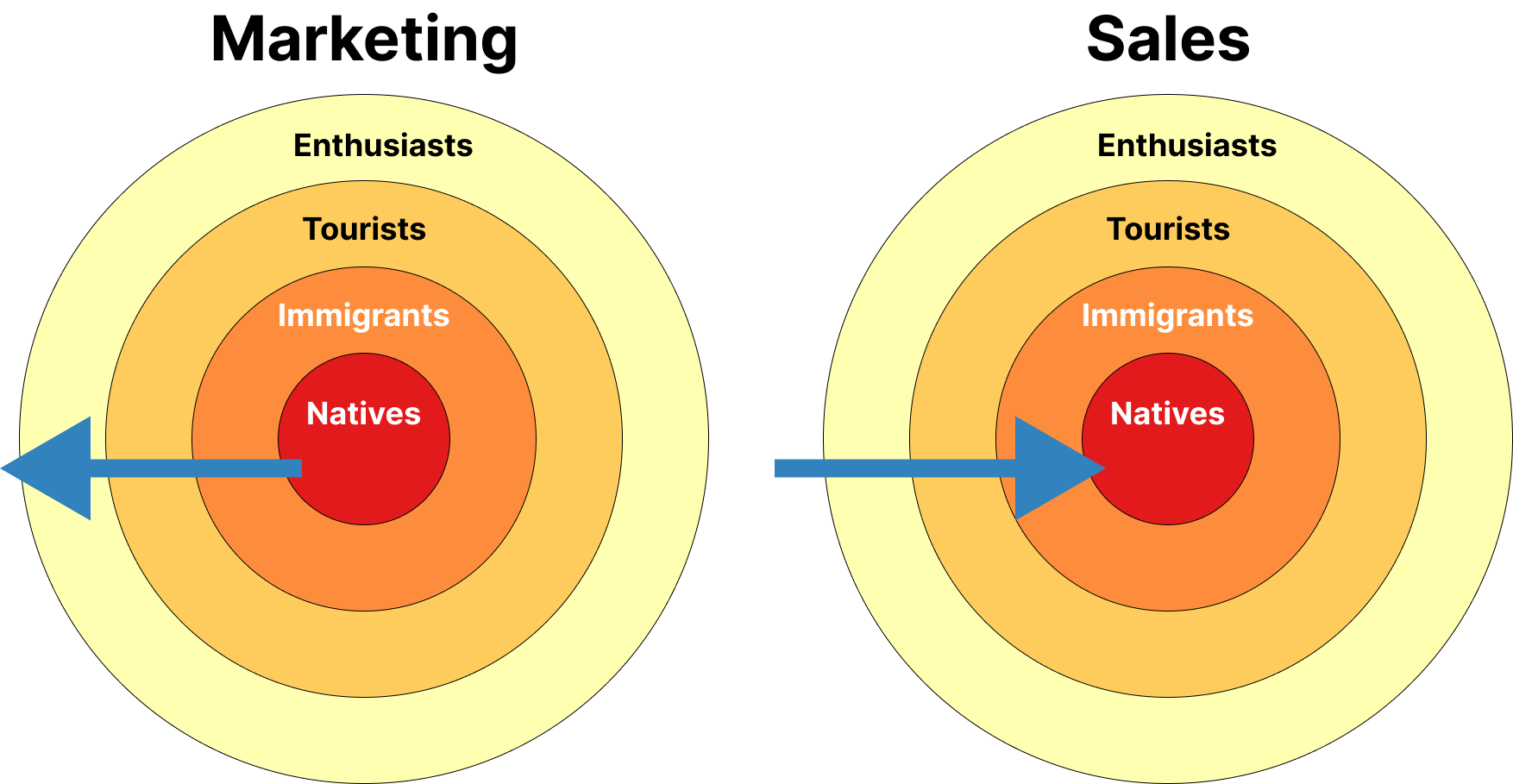
 Copied
CopiedWatch a child learn, and you’ll notice that most aspects of their development are information problems.
- Information: What is an 🍎? We need to teach children to call it an ‘apple’.
- Ability: How to draw with a ✏️? We need to teach children to hold a pencil and draw straight lines.
- Action: Should one eat 🥦 or 🍕? We need to persuade kids to build an appreciation for the former.
- Belief: Should one steal? We need to help children build a perspective about what’s good or bad.
 Copied
CopiedStrategizing content based on audience preferences isn’t sustainable because you’ll end up building an inauthentic identity. Instead, the content you create should reflect the life you live. It should articulate your experiences and insights.
Go pick a field where you have deep leverage — skill, judgment, network, location, culture, etc., or you have deep interest and thus are willing to jump into it fully.
Just do great things and talk about it. But for that, you first need to start building rigor for documentation and writing.
 Copied
Copied
Users spend 10x to 20x more time on social media compared to the time they spend on news media. Given that, it is recommended to invest in both native (on-platform) and social footprint and sell both as part of direct ads.
- Direct sales. Micro-celebrities can charge brands anywhere from Rs. 30,000 to a lakh for a social media post. Top cricketers charge a couple of crores for a post on their social media handles. This is especially true for videos.
- Subscriptions. Referral traffic from Twitter tends to give much higher subscription conversions compared to traffic from other sources like Facebook.
TV news anchors have a vast following. Do news companies monetize on their social following and do influencer deals?
“a growing trend of advertisers beefing up their influencer marketing budgets, including companies that you wouldn’t typically associate with creators. Next year, spending on influencer marketing in the U.S. is expected to rise nearly 15% to $5.89 billion, according to a forecast from Insider Intelligence.”
“Influencer marketing has been a way to reach customers who don’t know about the company. “The creator economy is huge for that because they’re hitting up people in various stages of the buying cycle,” said Ravichandran. “The person is not ready to buy, but then something will happen … like somebody tried to steal [their] credit card.” When that happens, the individual may remember the creator’s message and subscribe to Aura.”
– Why a Cybersecurity Startup Is Boosting Its Influencer Marketing Budget
 Copied
Copied
Ad Networks are AI-driven marketplaces owned by BigTech. These AI models are optimized to maximize revenue for the BigTech company. These models keep pushing the boundary of what is the lowest eCPM they can pay out. So if Hindi eCPMs are at Rs. 10, they will keep pushing the floor to Rs. 9.90 across a couple of months.
Hence, it is critical for news publishers to invest in AI to reverse push the boundary of the floor price up until the sell-through drops. By playing on buy and sell, you could see a 25% increase in programmatic revenue. Revenue from advertisements is seasonal. Hence, of course, do this during high-demand months (Oct-Nov-Dec) and play it conservatively from Jan 1.
 Copied
Copied

Programmatic and direct digital eCPMs are facing significant challenges, especially when it comes to the Hindi market where eCPMs are as low as Rs. 10.
- This scenario becomes even more problematic when considering the revenue distribution model, where ad networks, including giants like Google, claim as much as 50% of the top line.
- Google primarily operates on a performance-based buying mechanism, utilizing cost per click (CPC), whereas media purchases typically hinge on impression-based models (CPM). This dichotomy leads Google to reverse calculate CPC to CPM when making payouts to media, which invariably affects the bottom line.
- Additionally, the situation is compounded by the involvement of Supply-Side Platforms (SSP) and Demand-Side Platforms (DSP), which are in the business of constantly trading ads. These platforms further erode the margins, taking away a significant portion of the revenue in the process.
Based on the discussion within the cohort, we’ve come up with some rough estimates regarding India’s digital advertising market.
- It is valued at approximately Rs. 30,000 crore, which translates to about $4 billion.
- A substantial majority of this market, about 85% or Rs. 25,000 crore, is dominated by digital behemoths Google and Meta.
- In contrast, news publishers in the digital space have a much smaller slice of the pie. Their total digital advertisement revenue potential through direct sales stands at around Rs. 1000 crore, with a more optimistic estimate reaching up to Rs. 2000 crore.
- This estimation aligns with insights from Ashwin Padmanabhan of GroupM.
Changing scenario: With third-party cookie deprecation, Google’s revenue is expected to drop, and so is that of news publishers.
The direct sales pie is degrowing.


 Copied
CopiedI co-founded and ran Pykih, a profitable information design studio for five years before folding it. I can say with some authority that Gurman is probably India’s most talented journalist turned information designer! She has now founded ReVisual Labs, her own Information Design Studio. She can help you build competitive differentiation with immersives!
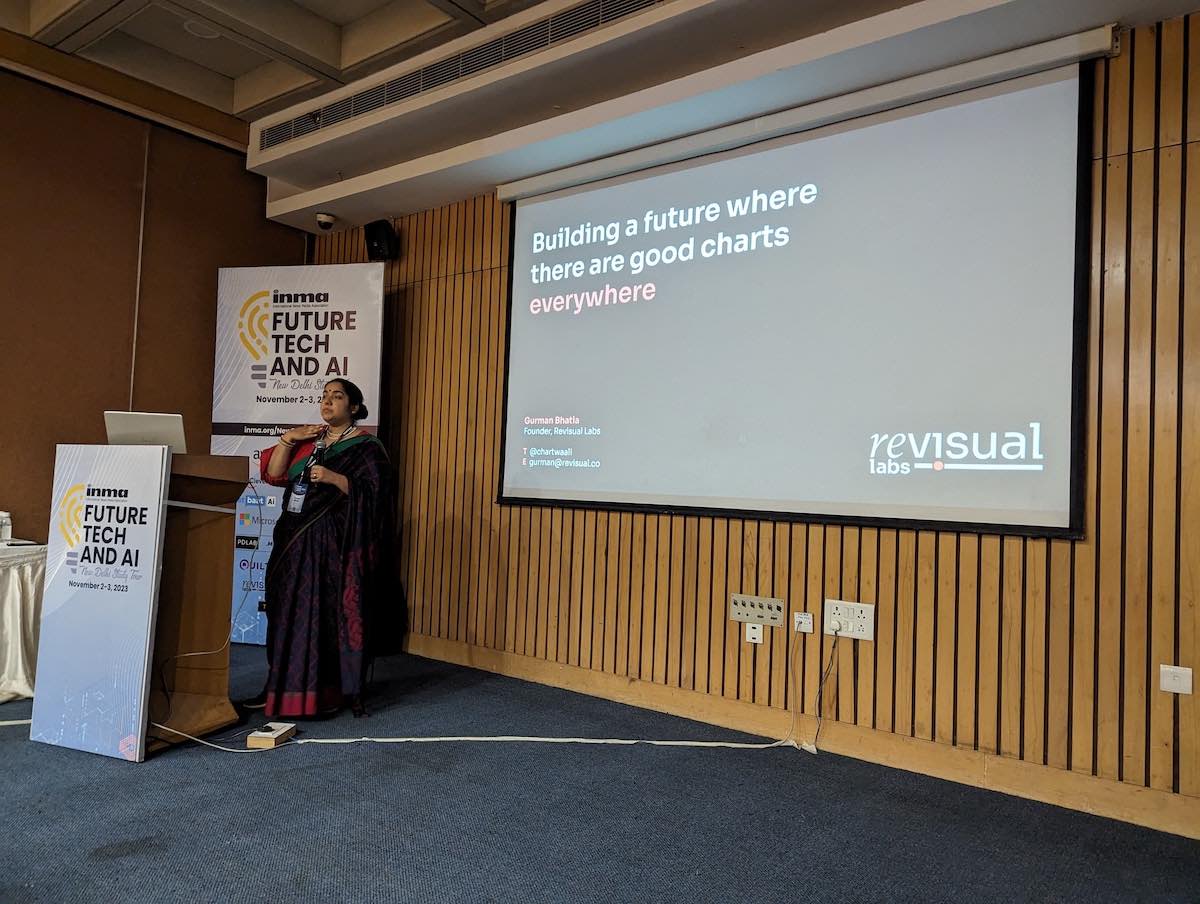


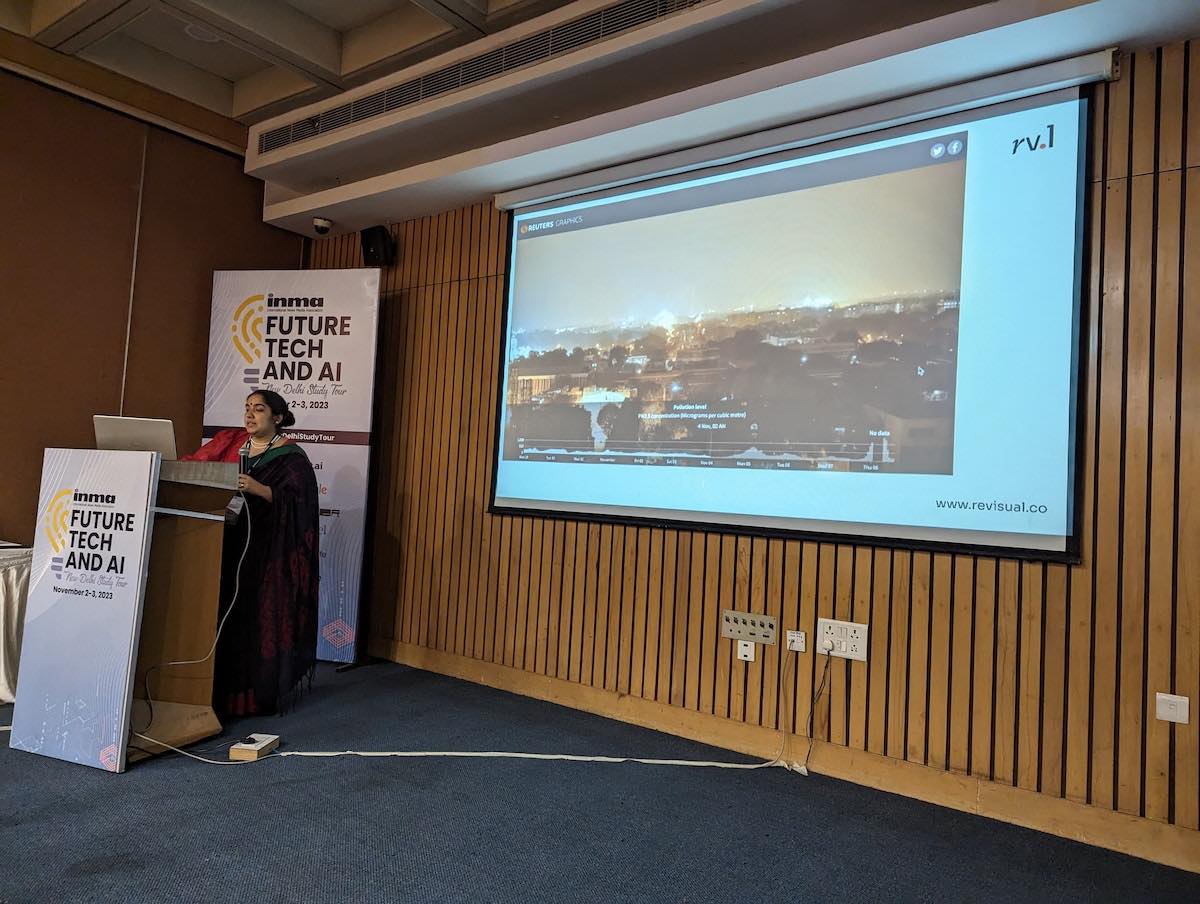
Opportunity: In an industry as commoditized as news, Gurman’s work can help you build competitive differentiation, especially for subscriptions.
- Investing in the creation of long shelf-life visual properties could be a strategic move.
- These properties hold the potential to capture audience attention during High Traffic Events or even foster a habit of daily engagement, thus aiming to enhance daily and monthly active users (DAU/MAU).
- The measure of success in this endeavor is subscription conversions and an uptick in DAU/MAU.
However, this approach is not without its risks.
- You might not be able to prove profit on a per-story basis. Hence, information design might not work for short-term, tactical stories.
- Moreover, integrating immersive stories into your current content management system (CMS) may prove to be complex and problematic.
- It’s also important to consider that immersive stories typically yield little in terms of search engine optimization (SEO) benefits, which can be a significant drawback for online visibility.
Thus, carefully consider if immersives works for your audience and if it does then invest big in it to get that competitive differentiation.
 Copied
CopiedWhy AI in CMS? In the past few months, integrating Generative AI into CMS has become table stakes! OpenAI’s ChatGPT APIs have made this a variable cost. Hence, we invited two CMSes.
WordPress
I deviate, but I want to spend a bit of time on why WordPress. In the last 10 years, I must have worked on multiple consulting projects to build CMS. Over the years, I’ve built a healthy appreciation for WordPress.
- Unless you have massive scale, there is limited direct financial ROI that newsrooms have to gain from building and investing in custom-built CMS. Some newsrooms are realizing it now. For example, VOX shut down its CMS and migrated to WordPress.
- Newsrooms got distracted building supply-side efficiency technology like CMS instead of revenue-generating advertisement targeting solutions.
Representing the WordPress community was Rahul Bansal from rtCamp. They are one of the sharpest WordPress agencies from Pune.
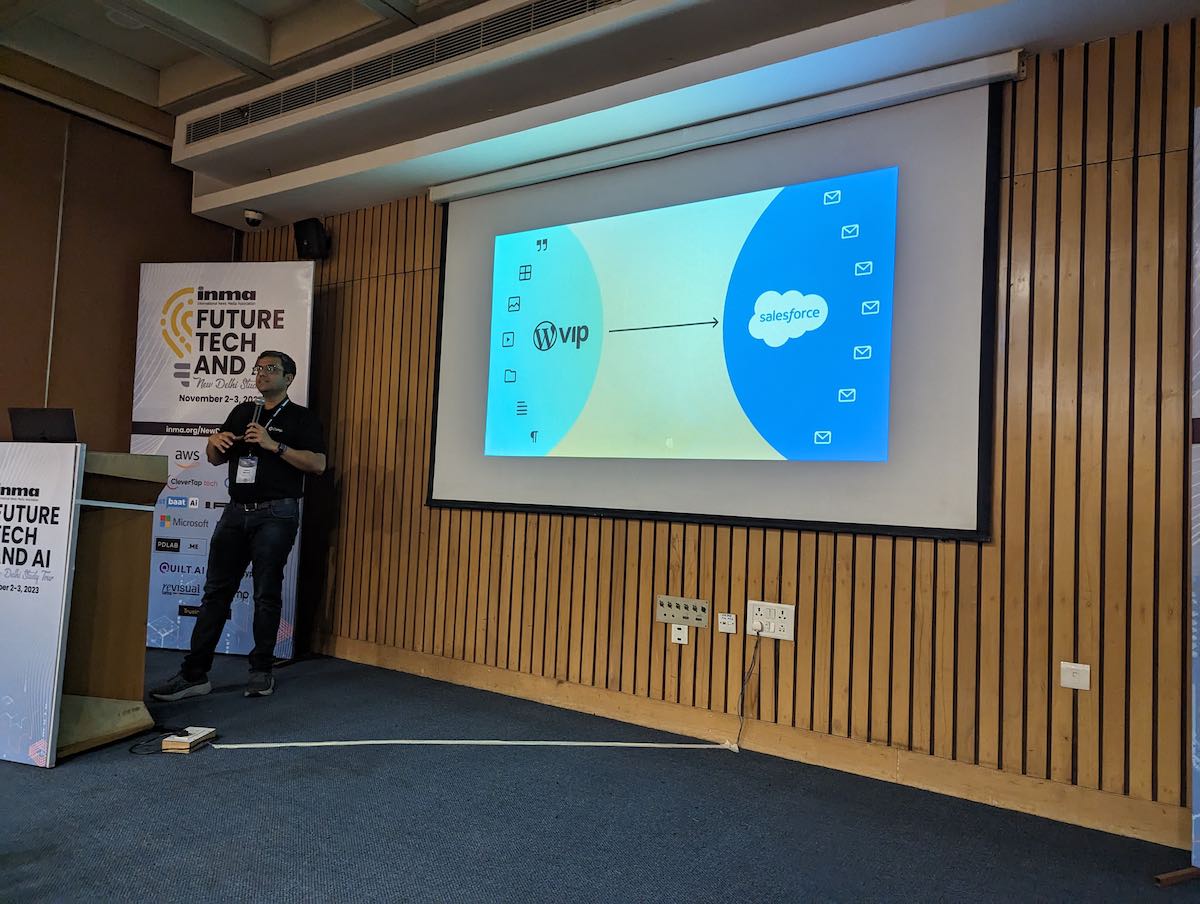
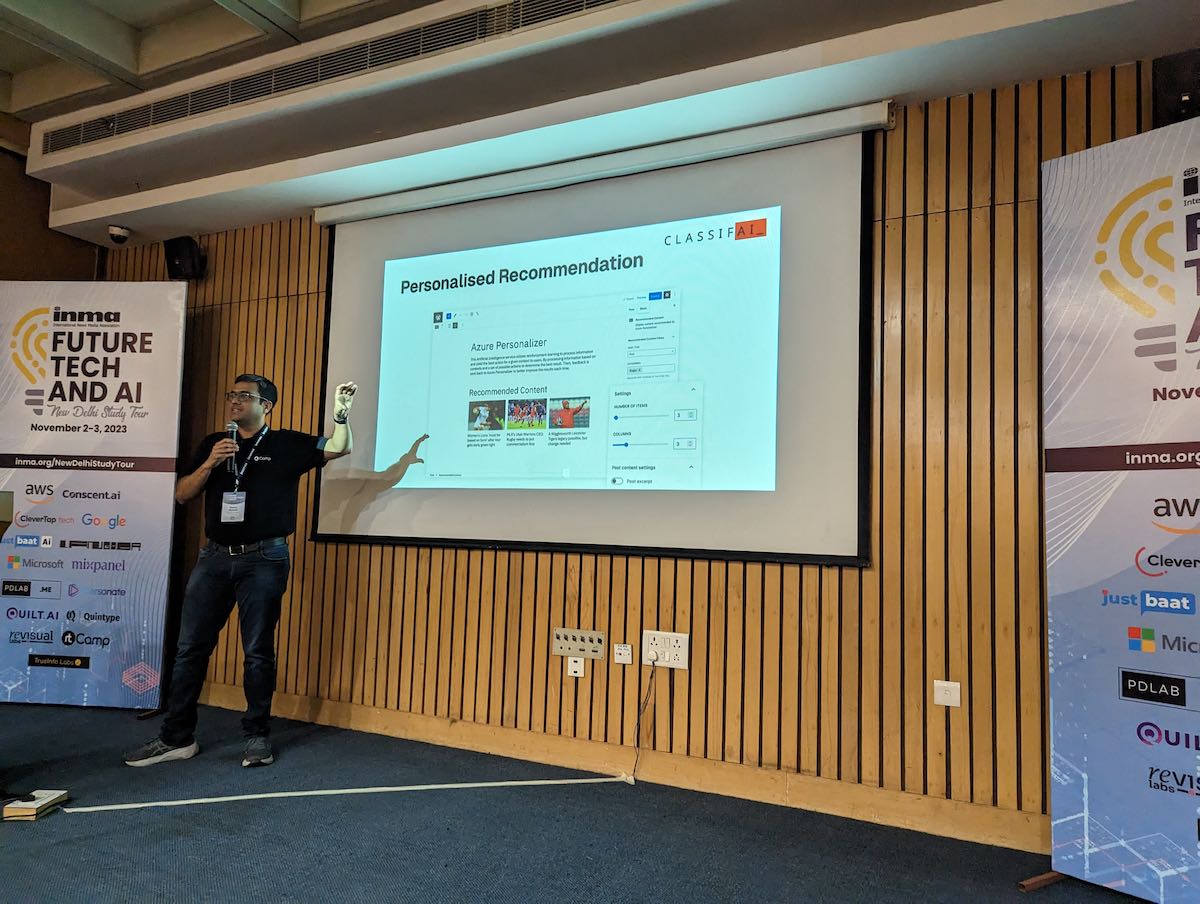
Here’s what Rahul shared:
- WordPress is a Lego-like modular system, and there are plugins for everything.
- Altis DXP provides editorial workflow assistance with ChatGPT.
- RankMath SEO, an Indian company, provides solutions to mass SEO-optimize content using LLMs.
- Elementor GUI plugin provides background removal solutions right inside of WordPress using LLMs.
- WPML integrates with different translation models.
- Akismet provides AI-driven content moderation.
- FalconAI generates outlines of articles using AI.
- etc.
Quintype
One of the most successful custom-built CMS in the market from India is Quintype. Over 200 publishers across the world use them! Chirdeep Shetty, their CEO, walks us through their AI integrations. According to him, LLMs are best left to the OpenAIs and Googles of the world, and the focus of Quintype is to get the UX right as per the workflow of the newsroom. Instead of me trying to explain what they do, I’d recommend watching the video below.
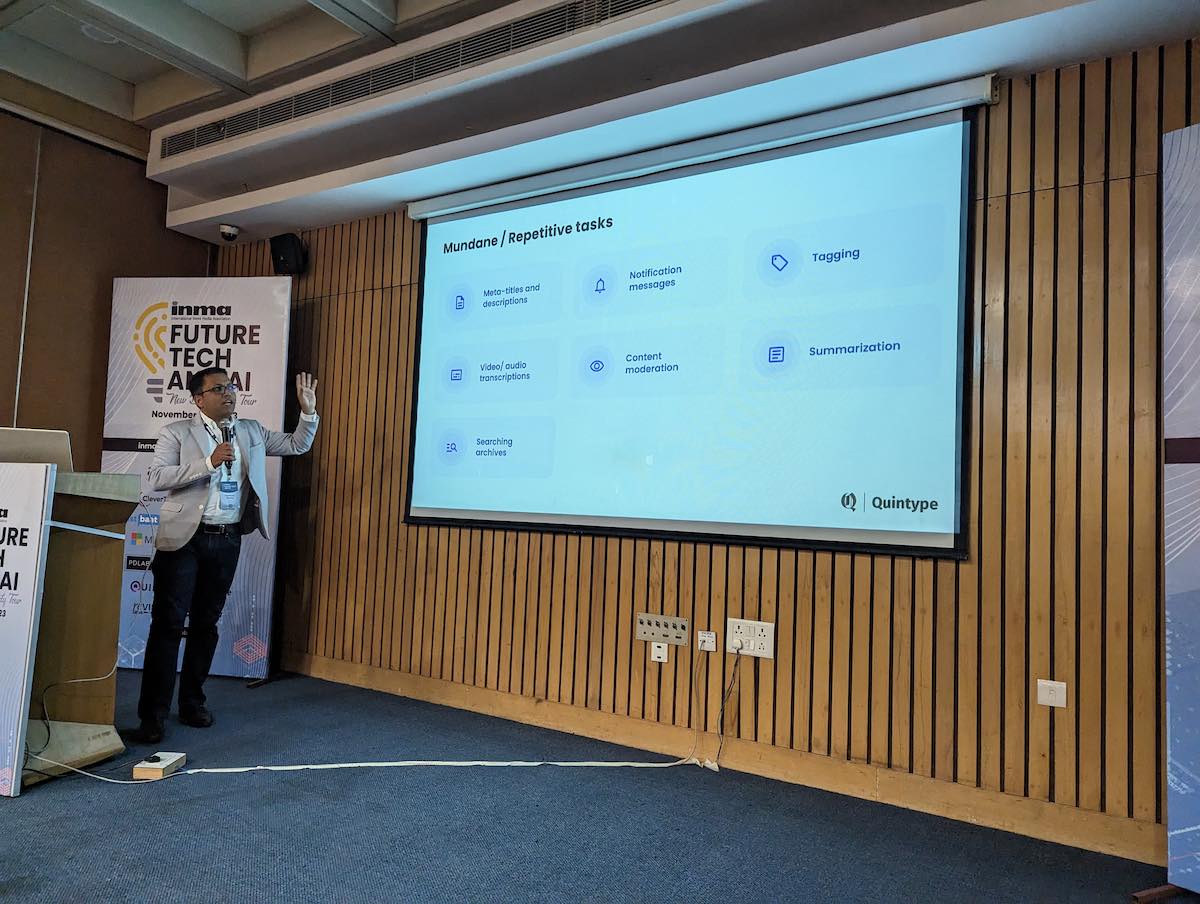
 Copied
Copied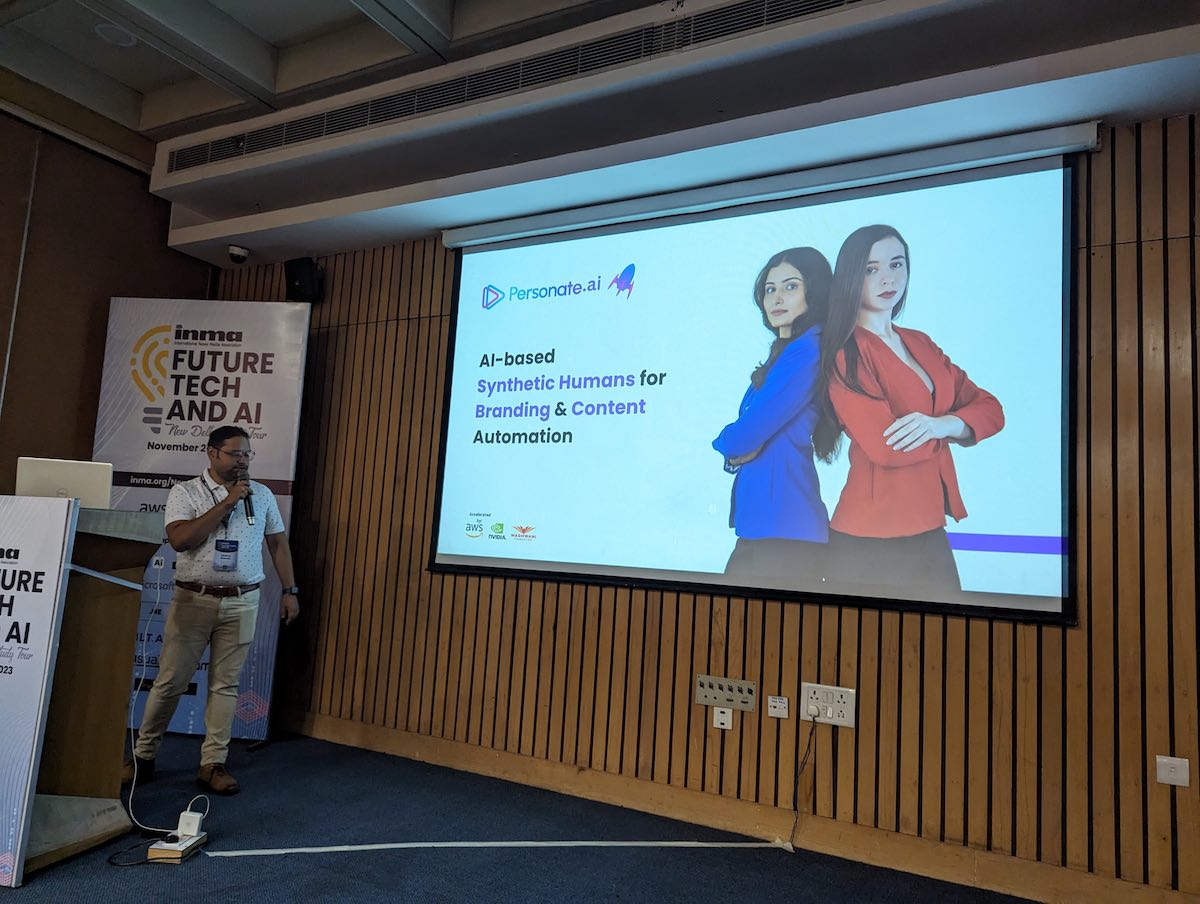
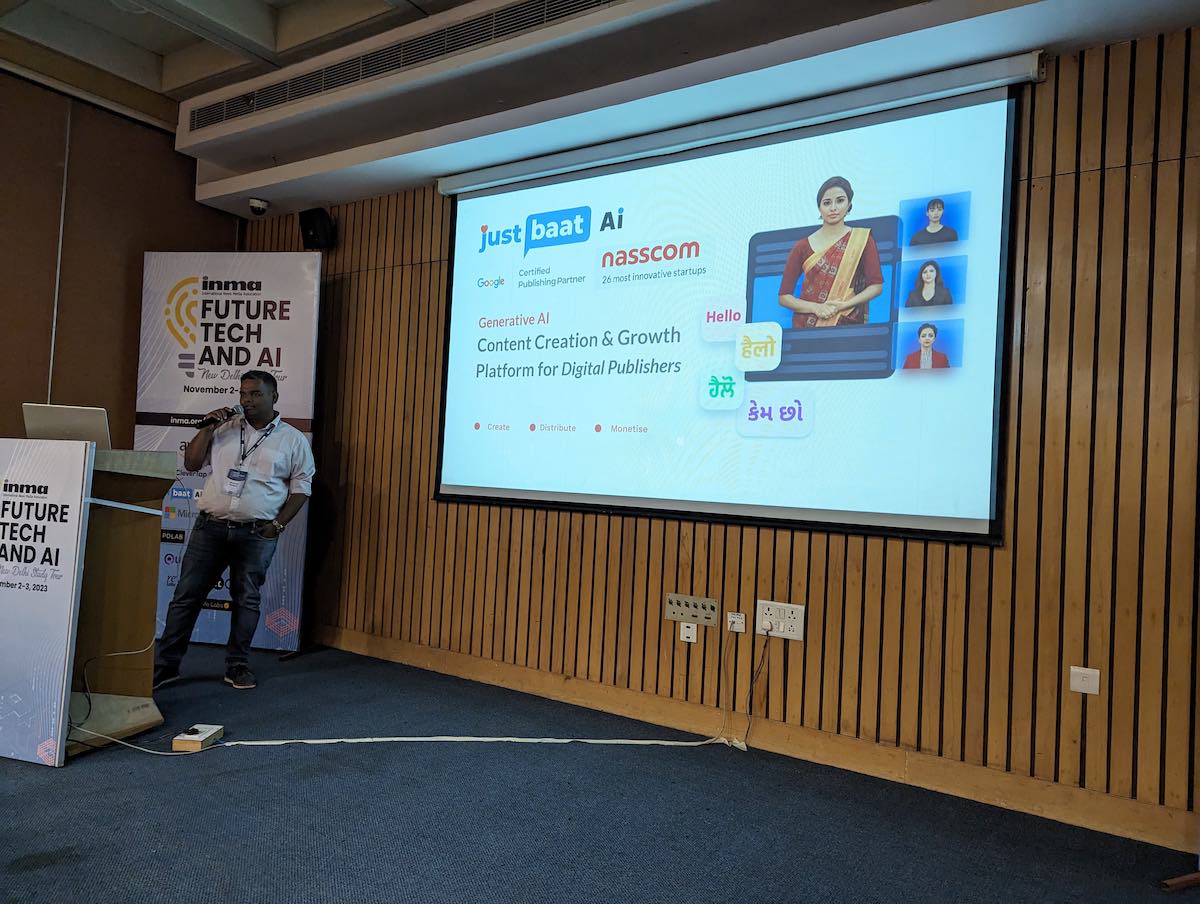
We had two vendors pitch: JustBaat.ai and Personate.ai. My assessment is that if you are not already, then go ahead and try out the technology.
Opportunity exists for those newsrooms that lack the “video DNA”. This technology can help bridge that gap and enable you to create videos at scale. It can also help you break away from the traditional reliance on celebrity anchors.
There is significant earning potential in video content since video eCPMs are higher compared to text. By tapping into video SEO and taking advantage of Google’s audio indexing, one can significantly boost visibility. Moreover, building brand IPs opens up opportunities for sponsorships.
Cost-saving is another critical factor to consider.
- Producing videos, especially at scale, is costly due to expenses such as shooting time, anchor salaries, and editing. This technology can help automate most of this.
- Furthermore, the capability to multi-publish textual stories in video format and to mass-create videos from automated data feeds, like air quality reports, stock market updates, and COVID-19 statistics, allows to drastically increase supply of videos.
However, risks should not be overlooked.
- The current state of the technology leaves much to be desired as the anchors, along with their expressions and gestures, can often appear artificial, though it’s important to note that advancements are being made rapidly.
- There’s a possibility that the content might be perceived as gimmicky if not executed well.
- Another concern is AI-driven marketplaces adjusting: as more publishers begin to use AI to mass-produce video content, there could be an oversupply, which might lead to a significant drop in video eCPMs. Therefore, it’s crucial to keep a close eye on expenditures and earnings from programmatic videos on a weekly basis to stay ahead of the curve.
Personally, I want to get my own synthetic avatar made and experiment deeply with this technology.
 Copied
CopiedTwitter, under Elon Musk, has made some wise investments to become Compute-Heavy.
- They’ve replaced a manpower-heavy safety team with personalization and community notes (AI-assisted crowd-sourced fact-checking).
- They are forcing users to subscribe. It might not be only for cash. Subscribers end up revealing their identity and get classified as digitally transacting users. Brands pay a premium to advertise to these folks.
- Finally, they’ve killed off the Twitter API, thereby protecting the data inside from being used by LLMs.
 Copied
Copied